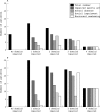Children with unexplained chronic pain: substantial impairment in everyday life
- PMID: 15899922
- PMCID: PMC1720481
- DOI: 10.1136/adc.2004.056820
Children with unexplained chronic pain: substantial impairment in everyday life
Abstract
Aims: To describe and quantify impairment in an outpatient population of children with chronic pain of unknown origin (UCP).
Methods: A total of 149 children who presented with pain of at least three months' duration and without a satisfactory explanation at presentation were studied. Number of somatic complaints (Children's Somatisation Inventory, CSI), pain intensity (VAS, 0-10 cm), functional disability (Child Health Questionnaire (CHQ-CF) and clinical history), and general health perceptions (CHQ) were determined.
Results: Mean age of the children was 11.8 years; 73% were girls. Overall, 72% suffered impairment in sports activities, 51% reported absence from school, 40% experienced limitations in social functioning, and 34% had problems with sleeping. Mean number of somatic symptoms differed significantly between boys (8.4) and girls (10.7). The CHQ-CF scores for physical functioning, role/social functioning, and general health perceptions were 76.4, 70.7, and 57.5, respectively, indicating substantial impairment on all domains. The mean pain intensity was 4.7 for current and 7.1 for worst pain. Children solely evaluated by a general practitioner prior to referral reported less, though still substantial, impairment. Low general health perceptions, impaired role/social functioning, high pain intensity, and having headache or musculoskeletal pain were independent predictors of having significant impairment.
Conclusions: Referred children with UCP show substantial impairment on multiple domains in daily life.
Figures



References
MeSH terms
LinkOut - more resources
Full Text Sources
Medical
